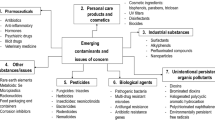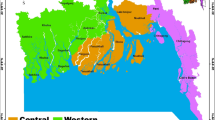Abstract
In recent years, various environmental issues have aroused a concern on the pollution of pesticides in rivers and in their various intercompartments. Multiple residues of pesticides discharged from industries or as a result of extensive use of agrochemicals in agriculture have been monitored. These pesticide residues contaminate the river ecosystem and its intercompartments such as sediments, and aquatic biota, and make it harmful to humans when they contaminate food and drinking water. The pesticide contamination in water, sediments, and aquatic biota has been reported to be beyond the acceptable range. The most commonly found pesticides are organochlorine, namely, dichlorodiphenyltrichloroethane, hexachlorocyclohexane, endosulfan, heptachlor, lindane, dieldrin, aldrin, endrin, and others. The paper discusses the general description, classification, and toxicity of pesticides; it also aims to create public awareness among people and appraise them with various alternate methods to combat the problem of pesticide contamination. An attempt has also been made to elucidate the findings of various works on pesticides in aquatic system and to highlight the challenging aspects of pesticide contamination, which have not attracted the attention of investigators yet.
Similar content being viewed by others
References
Agnihotri, N. P., Gajbhiye, V. T., Kumar, M., & Mohapatra, S. P. (1994). Organochlorine insecticide residue in Ganga river water near Farrukhabad, India. Environmental Monitoring and Assessment, 30, 105–112.
Ali, I., & Jain, C. K. (2000). Transportation behaviour of lindane in different types of soils, National Institute of Hydrology, Roorkee, Uttrakhand, India. Technical Report No. TR/BR-7/1999-2000.
Bakkore, N., John, P. J., & Bhatnagar, P. (2004). Organochlorine pesticide residues in wheat and drinking water samples from Jaipur, Rajasthan, India. Environmental Monitoring and Assessment, 98, 381–389.
Blanchard, M., Teil, M. J., Carru, A. M., Chesterikoff, A., & Chevreuil, M. (1997). Organochlorine distribution and mono-orthosubstituted PCB pattern in the roach (Rutilus rutilus) from the river Seine. Water Research, 31(6), 1455–1461.
Borga, K., & Bidleman, F. T. (2005). Enantiomer fractions of organic chlorinated pesticides in arctic marine ice fauna, zooplankton, and benthos. Environmental Science and Technology, 39, 3464–3473.
Bringas, L. M. F., Velez, G. P., Calva, L. G., Ugarte, I. H. S., Botello, A. V., & Gonzalez, G. D. (2008). Organochlorine pesticides in lacustrine sediments and tilapias of Metztitlan, Hidalgo, Mexico. International Journal of Tropical Biology, 56(3), 1381–1390.
Carlson, L. D., Basu, I., & Hites, A. R. (2004). Annual variations of pesticides concentrations in great lakes precipitation. Environmental Science and Technology, 38, 5290–5296.
Cerejeira, M. J., Viana, P., Batista, S., Pereira, T., Silva, E., Valerio, M. J., et al. (2003). Pesticides in Portuguese surface and ground waters. Water Research, 37, 1055–1063.
Chiuchiolo, A. L., Dickhut, R. M., Cochran, M. A., & Ducklow, H. W. (2004). Pesticides organic pollutants at the base of the Antarctic marine food web. Environmental Science and Technology, 38, 3551–3557.
Dabrowski, J. M., Peall, S. K. C., Niekerk, A. V., Reinecke, A. J., Day, J. A., & Schulz, R. (2002). Predicting runoff induced pesticide input in agricultural sub-catchment surface waters. Water Research, 36, 4975–4984.
Falandysz, J., & Strandberg, B. (2004). Persistent organochlorine compounds in sludge and sediments from the Gdañsk Region, Baltic Sea. Polish Journal of Environmental Studies, 13(2), 133–138.
Fu, S., Chu, S., & Xu, X. (2001). Organochlorine pesticide residue in soils from Tibet, China. Bulletin Environmental Contamination and Toxicology, 66, 171–177.
Gurunadha Rao, V. V. S., Sankaran, S., Prakash, B. A., Mahesh Kumar, K., Yadaiah, P., & Chandrasekhar, S. V. N. (2004). Persistence of pesticide residues in groundwater of Ludhiana and Muktsar districts, Punjab. Water quality—monitoring, modelling and prediction. In Proceedings of the 11th national symposium on hydrology with focal theme on water quality held at national institute of hydrology (pp. 291–301). Roorkee, India, 22–23 November, 2004.
Guo, Y., Meng, X. Z., Tang, H. L., & Zeng, E. Y. (2008). Tissue distribution of organochlorine pesticides in fish collected from the Pearl River Delta, China: Implications for fishery input source and bioaccumulation. Environmental Pollution, 155, 150–156.
Hans, R. K., Farooq, M., Babu, G. S., Srivastava, S. P., Joshi, P. C., & Vishwanathan, P. N. (1999). Agricultural produce in the dry bed of the river Ganga in Kanpur, India—A new source of pesticide contamination in human diets. Food and Chemical Toxicology, 37, 847–852.
Hu, Y. J., Aizawa, T., & Magara, Y. (1999). Analysis of pesticides in water with liquid chromatography/atmospheric pressure chemical ionization mass spectrometry. Water Research, 33(2), 417–425.
Iyamu, I. O. K., Asia, I. O., & Egwakhide, F. (2007). Concentrations of residues from organochlorine pesticide in water and fish from some rivers in Edo State Nigeria. International Journal of Physical Sciences, 2(9), 237–241.
Jayashree, R., & Vasudev, N. (2007). Organochlorine pesticide residues in ground water of Thiruvalllur district, India. Environmental Monitoring and Assessment, 128, 209–215.
Joiris, C. R., & Overloop, W. (1991). PCBs and organochlorine pesticides in phytoplankton and zooplankton in the Indian sector of the Southern Ocean. Antarctic Science, 3(4), 371–377.
Kannan, K., Kajiwara, N., Watanabe, M., Nakata, H., Thomas, N. J., Stephenson, M., et al. (2003). Profiles of polychlorinated biphenyl congeners, organochlorine pesticides and butylins in southern sea Otters and their prey. Environmental Toxicology and Chemistry, 23(1), 49–56.
Kiziewikz, B., & Czeczuga, B. (2003). DDT and its metabolites in the tissues of certain fish species from Podlasie province. Polish Journal of Environmental Studies, 12(1), 123–127.
Kucuksezgin, F., Uluturhan, E., & Kontas, A. (2001). Trace metal and organochlorine residue levels in red mullet (Mullus barbatus) from the eastern Aegean, Turkey. Water Research, 35(9), 2327–2332.
Kumari, A., Sinha, R. K., & Gopal, K. (2001). Organochlorine contamination in the fish of the River Ganges, India. Aquatic Ecosystem Health & Management, 4(4), 505–510.
Matin, M. A., Malek, M. A., Amin, M. R., Rahman, S., Khatoon, J., Rahman, M., et al. (1998). Organochlorine insecticide residues in surface and underground water from different regions of Bangladesh. Agriculture, Ecosystems & Environment, 69(1), 11–15.
Muhayimana, A. S., Shihua, Q., Yinghui, W., Xiangsheng, K., Owago, O. J., & Junpeng, Z. (2009). Distribution and sources of organochlorine pesticides (OCPs) in Karst Cave, Guilin, China. Journal of American Science, 5(1), 35–43.
Nayak, A. K., Raha, R., & Das, A. K. (1995). Organochlorine pesticide residue in middle stream of the Ganga river, India. Bulletin of Environmental Contamination and Toxicology, 54, 68–75.
Picer, M., & Picer, N. (1995). Levels and long term trends of polychlorinated biphenyls and DDT in mussels collected from the eastern Adriatic coastal waters. Water Research, 29(12), 2707–2719.
Quan, X., Niu, J. F., Chen, S., Chen, J. W., Zhao, Y. Z., & Yang, F. L. (2003). Effect of Fe2O3. Organic matter and carbonate on photocatalytic degradation of lindane in the sediment from Liao River. China, Chemosphere, 52, 1749–1755.
Qiu, X., Zhu, T., Yao, B., Hu, J., & Hu, S. (2005). Contribution of dicofol to the current DDT pollution in china. Environmental Science and Technology, 39, 4385–4390.
Rajendran, N., Rajendran, R., Matsuda, O., & Venugopalan, V. K. (1990). Organochlorine pesticides residue in zooplankton of a tropical estuary, South India. Bulletin of Plankton Society of Japan, 37(1), 59–68.
Sarkar, A., Nagarajan, R., Chaphadkar, S., Pal, S., & Singbal, Y. S. (1997). Contamination of organochlorine pesticides in sediments Arabian sea along the west coast of India. Water Research, 31(2), 195–200.
Said, T. O., & Hamed, M. A. F. (2005). Distribution of chlorinated pesticides in surface water and fish of el temsah and Bitter lakes, Suez canal. Egyptian Journal of Aquatic Research, 31(1), 200–212.
Schulz, R. (2001). Rainfall induced sediment and pesticide input from orchards into the Lourens river, Western Cape, South Africa. Water Research, 35(8), 1869–1876.
Schwab, A. P., Splichal, P. A., & Banks, M. K. (2006). Adsorption of atrazine and alachlor to aquifer material and soil. Water, Air and Soil Pollution, 177, 119–134.
Singh, P. B., & Singh, V. (2008). Pesticide bioaccumulation and plasma sex steroids in fishes during breeding phase from north India. Environmental Toxicology and Pharmacology, 25, 342–350.
Spongberg, A. L., Gottgens, J. F., & Muller, B. E. (2004). Pesticides accumulation rates in a managed marsh along Lake Erie. Water, Air and Soil Pollution, 152, 387–404.
Sudo, M., Kunimatsu, T., & Okubo, T. (2002). Concentration and loading of pesticides residues in Lake Biwa basin (Japan). Water Research, 36, 315–329.
Sun, P., Blanchard, P., Brice, K., & Hites, A. R. (2006a). Atmospheric organochlorine pesticides concentration near the Great Lakes: Temporal and spatial trends. Environmental Science and Technology, 40, 6587–6593.
Sun, P., Backus, S., Blanchard, P., & Hites, R. A. (2006b). Temporal and spatial trends of organochlorine pesticides in Great Lakes precipitation. Environmental Science and Technology, 40, 2135–2141.
Tanabe, S., Madhushree, B., Ozturk, A., Tatsukawa, R., Miyazaki, N., Ozdamar, E., et al. (1997). Persistent organochlorine residues in harbour porpoise (Phocoena phocoena) from the black sea. Marine Pollution Bulletin, 34(5), 338–347.
Waliszewski, S. M., Carvajal, O., Infanzon, R. M., Trujillo, P., Aguirre, A. A., & Maxwell, M. (2004). Levels of organochlorine pesticides in soils and rye plant tissues in a field study. Journal of Agricultural and Food Chemistry, 52(23), 7045–7050.
Wang, X., & Wang, W. X. (2005). Uptake absorption efficiency and elimination of DDT by phytoplankton, copepods and fish. Environmental Pollution, 136, 453–464.
Wong, S. C., Scott, M., Scott, A., Whittle, D. M., Backus, M. S., Teixeira, C., et al. (2004). Organochlorine compounds in Lake Superior: Chiral polychlorinated biphenyls and biotransformation in the aquatic food web. Environmental Science and Technology, 38, 84–92.
Willett, K. L., Ulrich, E. M., & Hites, R. A. (1998). Differential toxicity and environmental fates of hexachlorocyclohexane isomer. Environmental Science and Technology, 32, 2197–2207.
Vega, F. A., Covelo, E. F., & Andrade, M. L. (2007). Accidental organochlorine pesticide concentration of soil in Porrino, Spain. Environmental Quality, 36, 272–279.
Zhou, J. L., Rowland, S. T., Mantoura, F. C., & Lane, M. C. G. (1997). Deabsorption of tefluthrin insecticide from soil in simulated rainfall runoff systems—Kinetic studies and modeling. Water Research, 31(1), 75–84.
Author information
Authors and Affiliations
Corresponding author
Rights and permissions
About this article
Cite this article
Chopra, A.K., Sharma, M.K. & Chamoli, S. Bioaccumulation of organochlorine pesticides in aquatic system—an overview. Environ Monit Assess 173, 905–916 (2011). https://doi.org/10.1007/s10661-010-1433-4
Received:
Accepted:
Published:
Issue Date:
DOI: https://doi.org/10.1007/s10661-010-1433-4




